
The German WWII Luftwaffe Paratrooper Combat Badge -
During World War II, the German Air Force (Luftwaffe) raised a variety of airborne light infantry units, known
as the Fallschirmjäger, or "paratroopers". At first, before the war, the forces were a part of
the Army. Later they became a part of the German Air Force.
| BY THE NUMBERS |
- Over 54,449 paratroops were killed in action.
- Over 8,000 paratroops are still listed as missing in action.
- Paratroopers were issued a total of 134 Knight's Cross of the Iron Crosses between the years 1940-1945.
|
|
Starting from a small collection of Fallschirmjäger battalions at the beginning of the war, the Luftwaffe
built up a division-sized unit of three Fallschirmjäger regiments plus supporting arms and air assets,
known as the 7th Flieger Division (7th Air Division).
Fallschirmjäger units made the first airborne invasion when invading Denmark on the 9 April 1940. In the
early morning hours they attacked and took control of Aalborg airport which played a key role acting as a
refuel station for the Luftwaffe in the further invasion into Norway. In the same assault the bridges
around Aalborg were taken. Other airborne attacks on Denmark the 9 April were also carried out, including
one on a fort on the island Masnedo.
|
After mid-1944, Fallschirmjäger were no longer trained as paratroops due to the realities of the strategic situation, but retained the Fallschirmjäger honorific. Near the end of the war, the series of new
Fallschirmjäger divisions extended to over a dozen, with a concomitant reduction in quality in the higher-numbered units of the series. Among these divisions was the 9th Fallschirmjäger Division, which was the
final parachute division to be raised by Germany during World War II.
The division was destroyed during the Battle of Berlin in April 1945. (These divisions should not be confused with the Luftwaffe Field Divisions, a poorly organised and managed series of light infantry divisions raised
from excess Luftwaffe personnel early in the war.)
A special version of the German armed forces' (Wehrmacht's ) modernized steel helmet (stahlhelm), the M1935, called the Fallschirmhelm, was designed and issued to Fallschirmjäger units. It did away with the projecting
visor and deep, flared rim of the standard-issue helmet, and added further improvements. The modified shell
incorporated a completely different and more substantial leather liner and chinstrap design that provided far
more protection for German airborne troops; this model was known as the M1938.
Fallschirmjager would be awarded the Fallschirmschützenabzeichen, a Paratrooper Insignia featuring a
diving gold eagle gripping a swastika.
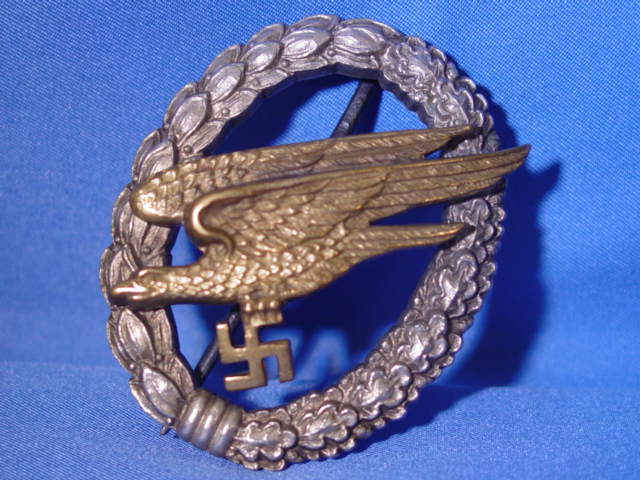
The Air Force paratrooper badge was authorized on November 5th, 1936 by the Minister of Aviation. The
badge was issued in a blue box with an award document. The soldier would wear it on the left side of the
uniform in a vertical position.
The design of the badge consisted of an oval metal wreath. The left half of the oval is adorned with
laurel leafs while the right side has oak leafing. The bottom of the oval terminates on a three
circle ring that simulates holding the wreath together. A diving eagle is placed across the wreath in
a downward angle. It is facing left and it is clutching a swastika.
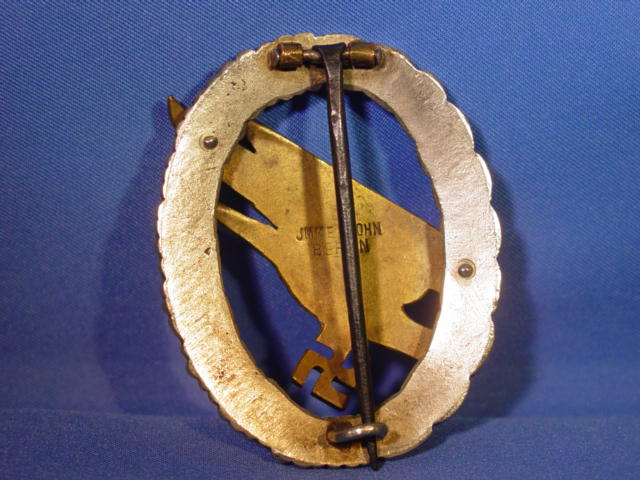
The back of the badge shows the two piece construction. The laurels (circle) being one piece while the
eagle makes the second part. Both pieces are secured together by rivets. It is very important to take a
close look at the rivets becausethis is one of the ways in which the fakes can be distinguished. Most of
the reproductions do not do a good job of duplicating the rivets.
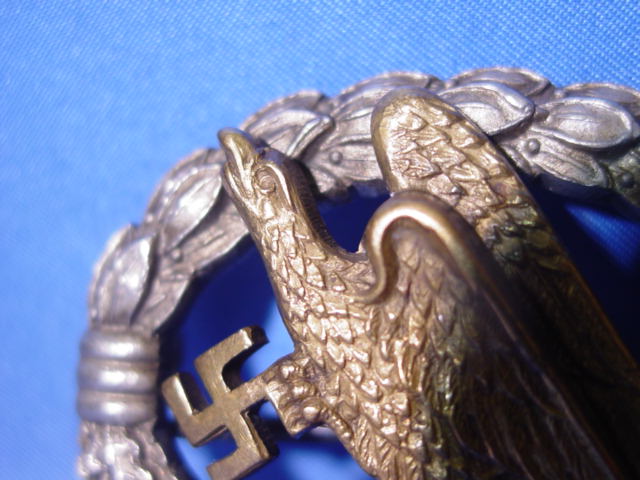
A close up view of the head and wings show the high quality detailing in the execution of manufacturing.
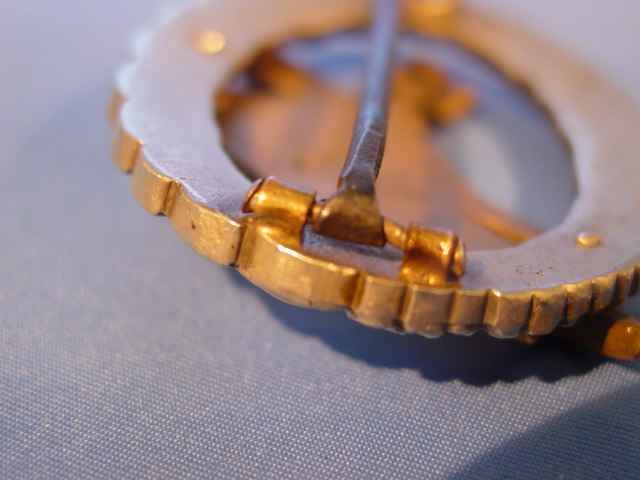
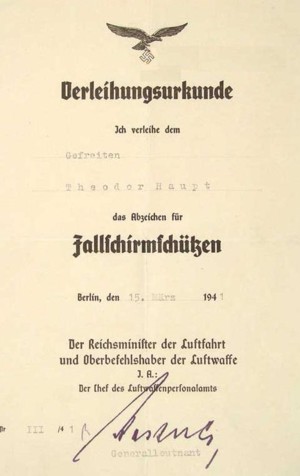 |
The qualifications for earning the Luftwaffe Paratrooper badge includes.
|
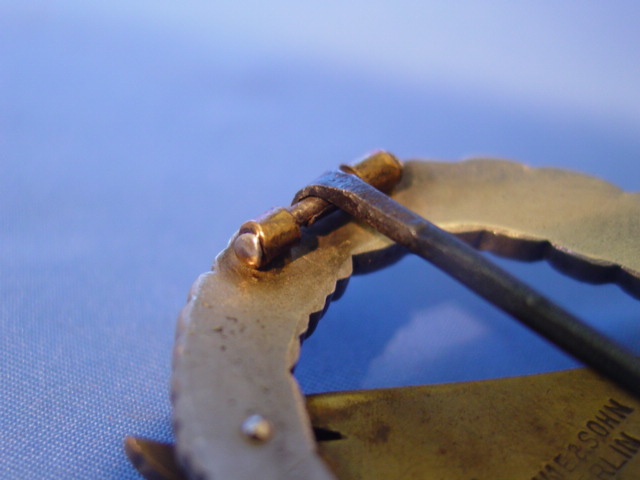
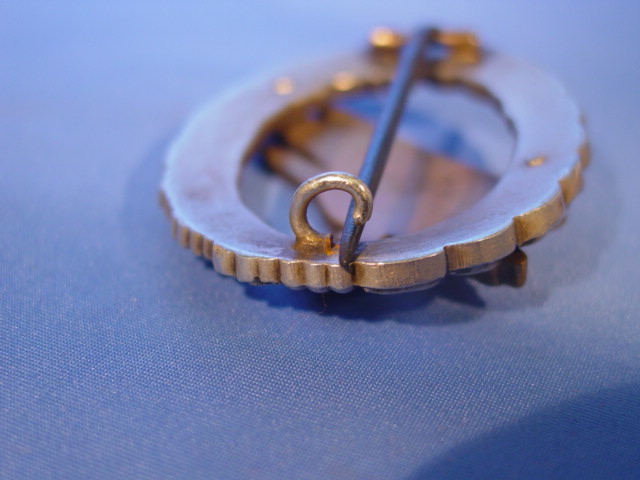
Here is a view of the WWII German Paratrooper badge pin catch. It secured the pin in the close postion so
the badge would not fall off the uniform. There were multiple companies who manufactured the paratrooper
(Fallschirmjäger) badge. Weights and sizes may have varied from manufacturer to manufacturer prior to the introduction of RZM controls. This particular sample shows the
manufacturer's logo
stamped to the back of the eagle.
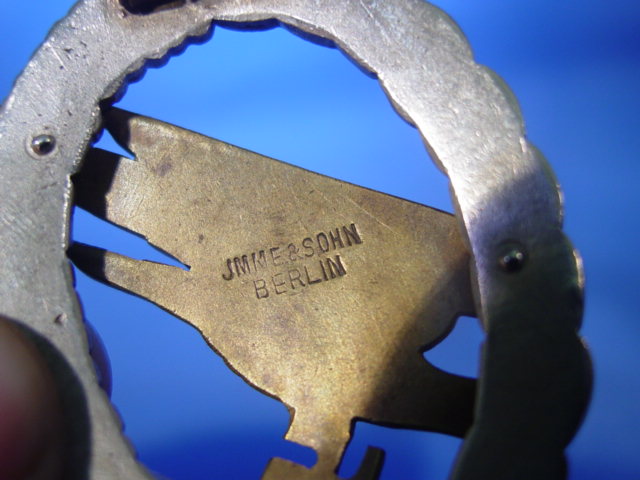
|
This page is a recognition and identification guide for WWII German badges and awards. Multiple
detailed photos of a specific sample are provided. Descriptions point out clearly defined points
that should be noted.
One of the most commonly asked questions is "How much is my WWII German badge worth?". A price
guide is included here to address this question. The value of the badges and awards is reviewed
over a period of several years. A trend can be observed. The present worth of the German
badges in the collector's market is illustrated.
This service is provided free of charge to the visitor/enthusiast courtesy of
MilitaryItems.com,
a company dedicated to the preservation of military history and to providing quality military
antiques and collectibles to museums, institutions and the general public.
|
|
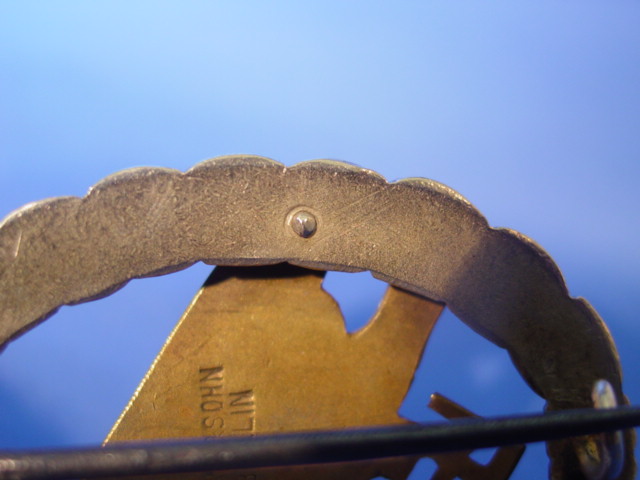
The following picture provides a very good view of the rivet that secures the eagle to the wreath. Also
notice the nice detailing to the plumeage on the wings.
The soldier wore the badge on the
uniform tunic.
It was secured in place by passing the badge's pin through a series of loops, two or more, that
were sewn in the jacket.
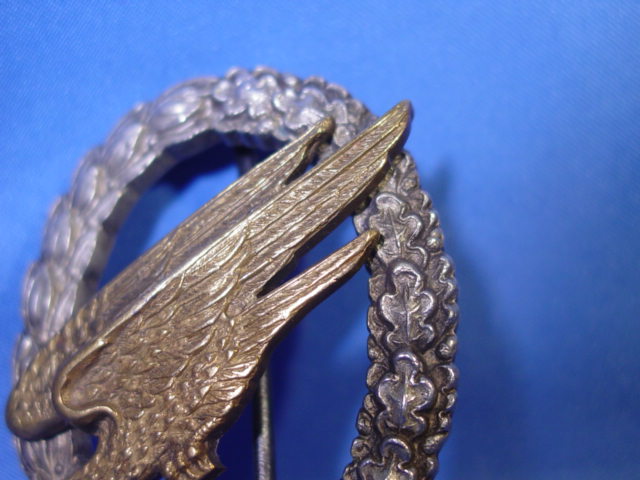
This award is currently being
reproduced.
It is becoming more difficult to be able to tell the fake ones from the real ones because the quality
of the reproductions is improving. The collector must become familiarized with the construction style
and materials employed in the manufacturing of this badge. Attention to the details is critical in
order to be able to determine the authenticity of the badge.
If you have an interest is seeing other badges and awards of the Third Reich, you can do so by going
to our
WWII German Badges and Awards
identification guide. Where we cover Heer (Army), Navy (Kriegsmarine) and
Air Force (Luftwaffe) items.
| GERMAN WWII LUFTWAFFE PARATROOPER BADGE VARIATIONS |
The Luftwaffe Fallschimjager badge was produced by several manufacturers and in different
configurations. The following section displays some of the different types that were manufactured. It is a good
idea for a collector to get acquainted with as many examples of a badge as possible. This experience enhances
the nkowledge base on the topic.
|







